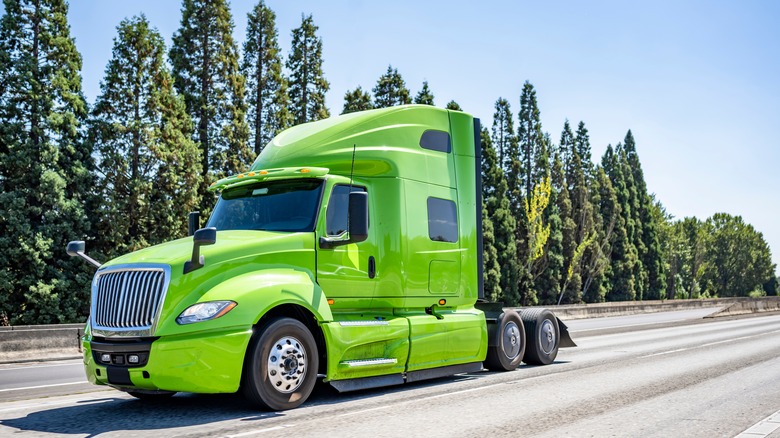What Does 'Semi' Mean On A Semi Truck?
Even though we see them almost every day on the roads and highways, it's easy to still be overwhelmed by the gargantuan size of a semi-truck. It may seem odd to consider a machine as massive as a 72-foot-long, 80,000 pound 18-wheeler as a "semi" anything, but nevertheless, that's what they're called. If that label alone seems confusing, the reasoning behind this moniker can also be somewhat tricky to decipher.
The simplest way to understand it is that semi-trucks are made up of two portions, the tractor and the trailer. The tractor, also known as the truck, leads the vehicle, making up the upper half of that houses the motor and seats the driver. The back half is made up of a detachable trailer that carries the load. While the original name for these machines was semi-trailer-truck, the shortened "semi-truck" became the more commonplace term as time went on.
The "semi" title is meant to describe the trailer itself rather than the truck, in particular any trailer that only possess rear axles, uses a fifth wheel to connect to the tractor, and is significantly longer in order to support heavy loads. It's a "semi" trailer because it doesn't have its own engine, front axles and wheels, transmission, and so on. Thus, "semi-truck" is a nickname for a truck that carries a semi-trailer.
However, depending on the vehicle you're looking at or the location you're in, there are other names you might hear semi-trucks go by. Terms such as semi-tractor, tractor-trailer, or semi-tractor-truck are common plays on the usual name, while 18-wheeler and big rig are used in regions such as the Northeast and South.
So what's the difference between a semi-truck and a truck?
Chances are, you never thought twice about the difference between semi-trucks and regular trucks in much depth before. Now that you know what makes up a semi-truck, however, you may be wondering what makes regular trucks different. Understanding the differences between these machines is key to knowing what's best suited for what task.
As we mentioned prior, semi-trucks are mainly defined by having a detachable trailer that is used to support their loads. A regular truck, otherwise known as a box or straight truck, contains only a single chassis with no additional storage attachments. These include moving trucks from the likes of U-Haul and similar companies, garbage trucks, and street sweepers. Despite the use of "semi" in the name, semi-trucks are typically much larger than straight trucks and can carry heftier loads, as the trailers in the back give them increased support options. And while straight trucks can vary in size, they are usually smaller and used for lighter jobs.
As a result of their size and capacity differences, there are some economical aspects to keep in mind when deciding between both truck types. Obviously, the larger semi-trucks cost more to purchase and maintain on average, while also requiring a bit more of a learning curve to operate. This can be worrisome given the extensive expenses that commercial owner-operators have to deal with regularly, such as repairs, insurance, and diesel fuel. Straight trucks cost less, but depending on the load you'll be carrying, a semi-truck will require fewer trips and make jobs go by more efficiently.

